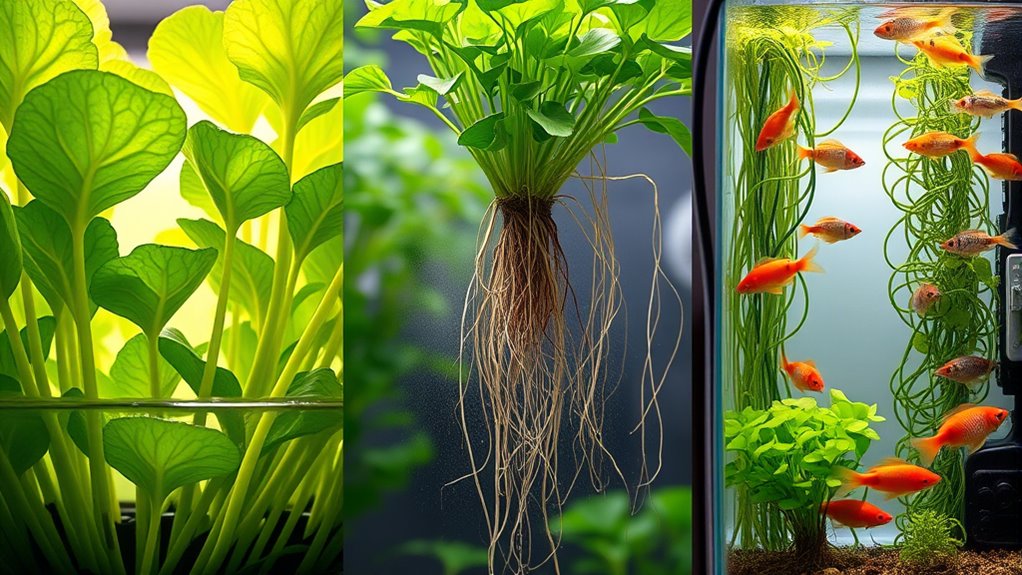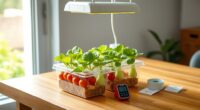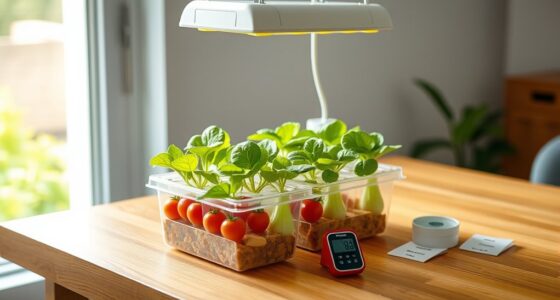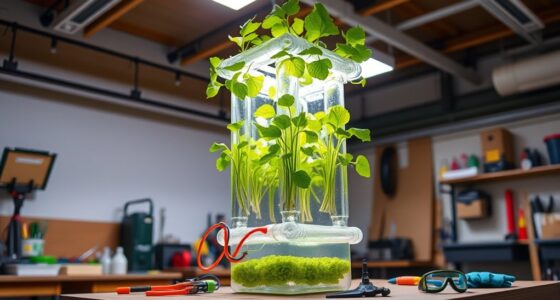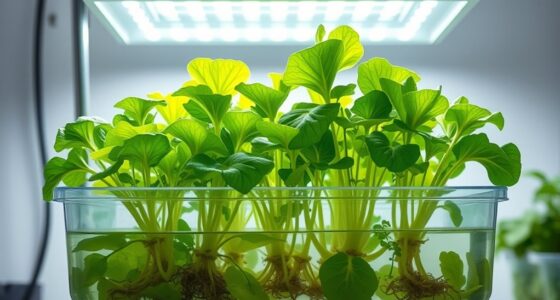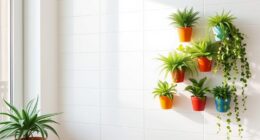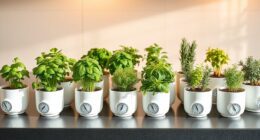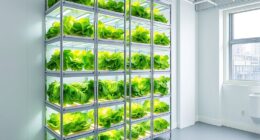Choosing between hydroponics, aeroponics, and aquaponics depends on your goals. Hydroponics offers reliable yields and is accessible for beginners, though it requires significant setup. Aeroponics provides faster plant growth with minimal water use but needs specialized equipment. Aquaponics combines fish and plants for sustainability but adds complexity. Consider your space, budget, and skills. Want to discover which system suits your needs best? Keep exploring to find the perfect fit.
Key Takeaways
- Choose hydroponics for reliable, high-volume crop production with moderate initial costs and straightforward maintenance.
- Opt for aeroponics for faster plant growth, minimal water use, and suited for high-tech, space-conscious environments.
- Select aquaponics for sustainable, eco-friendly systems combining fish and plant growth, ideal for resource recycling and biodiversity.
- Consider system complexity and technical skills; hydroponics is beginner-friendly, while aeroponics and aquaponics require more expertise.
- Match crop types and space constraints to the system’s scalability, with vertical setups maximizing urban and limited-space environments.
Understanding the Basics of Soil-Less Cultivation
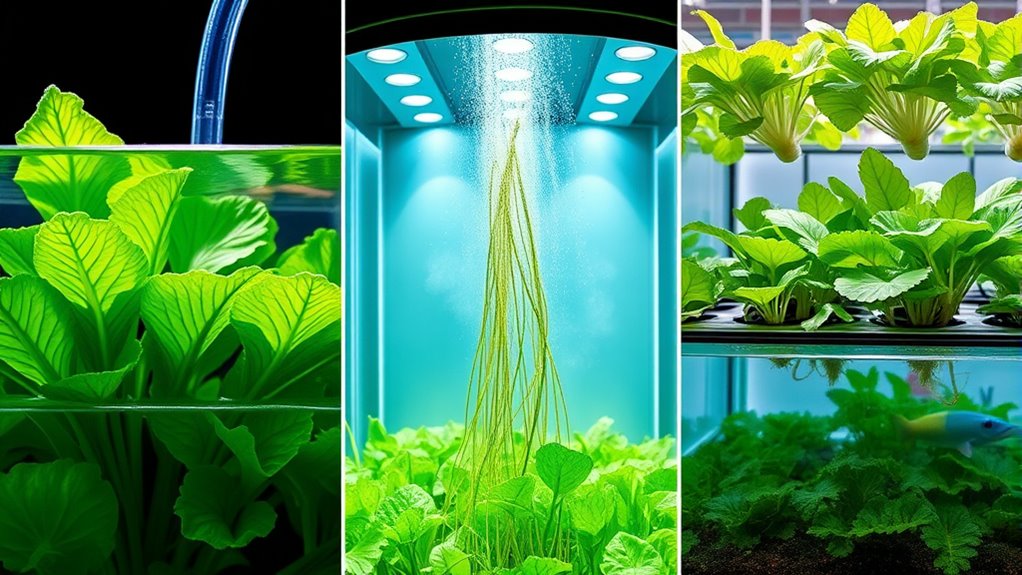
Soil-less cultivation methods like hydroponics, aeroponics, and aquaponics eliminate the need for traditional soil by growing plants in nutrient-rich water or air. Instead of relying on soil health, these systems depend on carefully controlled environments to deliver essential nutrients directly to plant roots. In soil-based farming, microbial activity plays a crucial role in breaking down organic matter and maintaining soil fertility. However, in soil-less setups, you replace this natural microbial activity with engineered nutrient solutions or aerated water, which supply what plants need without soil. This approach reduces the risks of soil-borne diseases and pests, offering a cleaner, more controlled way to grow crops. Additionally, understanding how different technology influences plant growth can help optimize these systems for better yields. Understanding these basics helps you appreciate how soil-less systems optimize plant growth without traditional soil’s complexities.
Comparing Growth Rates and Crop Yields
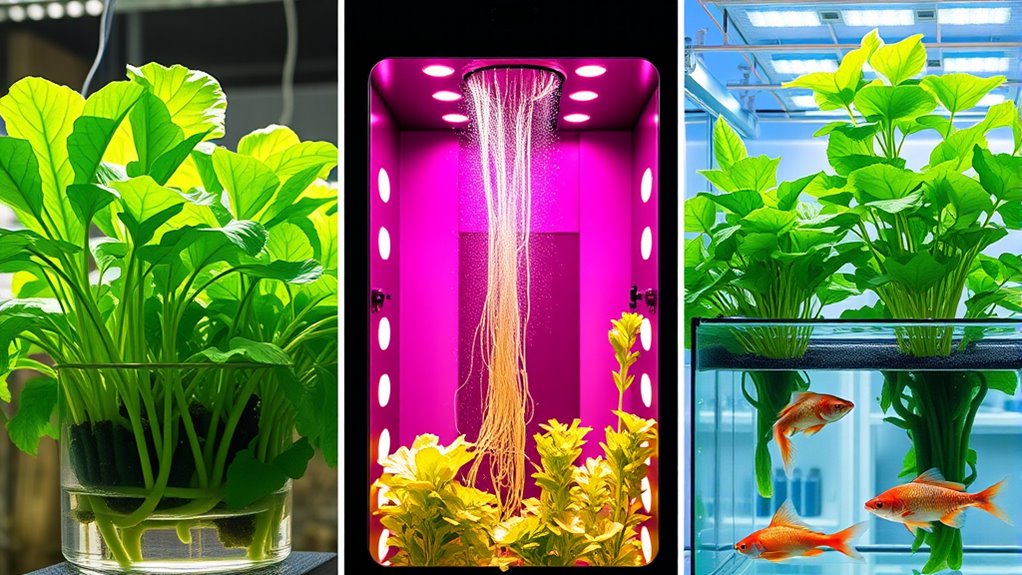
When comparing growth rates and crop yields among hydroponics, aeroponics, and aquaponics, you’ll find that each method offers distinct advantages depending on the crop and system setup. In a growth rate comparison, aeroponics typically results in faster development due to its nutrient delivery directly to the roots. Hydroponics provides steady, reliable yields, making it ideal for consistent crop production. Aquaponics combines fish and plant growth, often leading to slightly slower but sustainable yields. Visualize lush, vibrant plants thriving in nutrient-rich solutions, roots dangling freely in mist, or fish swimming beneath flourishing greenery. By conducting a thorough crop yield analysis, you’ll see that aeroponics often outperforms others in speed, while hydroponics excels in volume. Aquaponics offers a balanced approach, blending productivity with eco-friendliness.
Analyzing Resource Efficiency and Sustainability
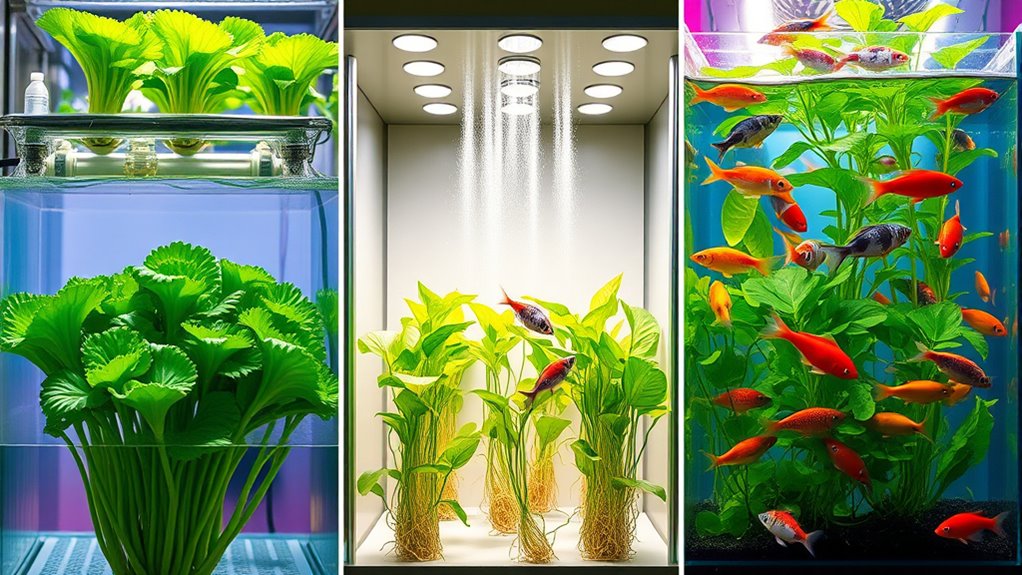
When evaluating resource efficiency, you should consider how each system conserves water and recycles nutrients. You also need to assess their overall environmental impact, including energy use and waste management. Understanding these factors helps you choose the most sustainable method for your needs. Additionally, considering the cost and budgeting involved in each system can aid in making an informed decision.
Water Usage Efficiency
How efficiently do hydroponics, aeroponics, and aquaponics use water resources? These systems excel in water conservation and irrigation efficiency, but their effectiveness varies.
A new sentence with multi-functional furniture and the rest of the sentence.
Nutrient Recycling Methods
Nutrient recycling methods are central to maximizing resource efficiency and sustainability in hydroponic, aeroponic, and aquaponic systems. By effectively recycling nutrients, you reduce waste and lower the need for external fertilizer inputs. In hydroponics and aeroponics, nutrient solutions are continuously recirculated, minimizing waste management issues and conserving resources. Aquaponics combines fish waste with plant nutrients, naturally recycling nutrients through biological processes, which enhances sustainability. Proper nutrient recycling guarantees plants receive consistent nutrition while preventing excess runoff that could harm the environment. Implementing efficient waste management practices not only optimizes resource use but also reduces operational costs. Additionally, understanding the role of affiliates and transparency in these systems can help you make informed decisions about sourcing equipment and supplies. Overall, these methods are crucial for creating sustainable farming systems that prioritize both productivity and environmental responsibility.
Environmental Impact
Evaluating the environmental impact of hydroponics, aeroponics, and aquaponics reveals differences in resource efficiency and sustainability. Aeroponics uses minimal water and nutrients, reducing runoff and waste, while aquaponics combines fish and plants, creating a self-sustaining system that conserves water. Hydroponics often relies on artificial lighting and energy-intensive equipment, but integrating solar energy can lessen its carbon footprint. Pest control varies: aeroponics minimizes chemical use, and aquaponics benefits from natural pest management via fish waste. Material durability is also a key factor influencing the longevity and environmental impact of systems. Visualize:
- Sun-powered grow rooms harnessing solar energy
- Roots dangling in nutrient-rich mist or water
- Fish swimming peacefully beneath plant beds
- Pest control happening naturally, without pesticides
These factors highlight each system’s potential for eco-friendly farming.
Assessing Setup Costs and Maintenance Requirements
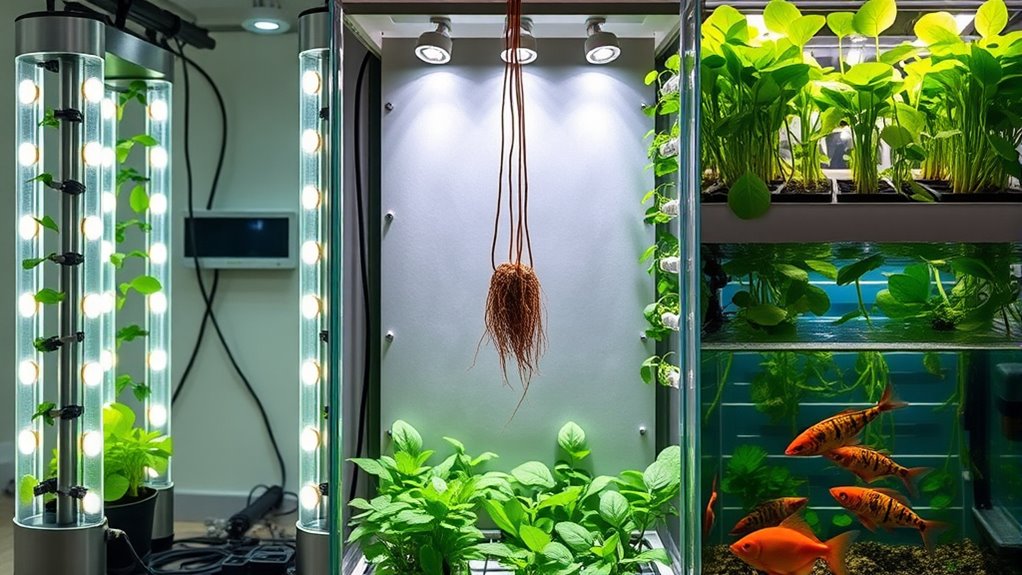
Setting up a hydroponic system typically requires a significant initial investment, including purchasing grow trays, pumps, reservoirs, and lighting equipment. When considering cost comparison, hydroponics can be more expensive upfront than other systems due to equipment needs. Maintenance complexity varies; hydroponic setups often demand regular monitoring of nutrient levels, pH balance, and system cleaning to prevent clogs and algae growth. Nutrient management is crucial for optimal plant health and productivity in hydroponic systems. Aeroponics may have higher initial costs because of specialized misters and sealed chambers but can be easier to maintain once established. Aquaponics combines fish tanks and plant beds, which can lower setup costs but increases ongoing maintenance, including fish health management and water quality. Overall, each system’s costs and maintenance requirements depend on scale, equipment quality, and your level of experience.
Examining Environmental Impact and Ecosystem Benefits
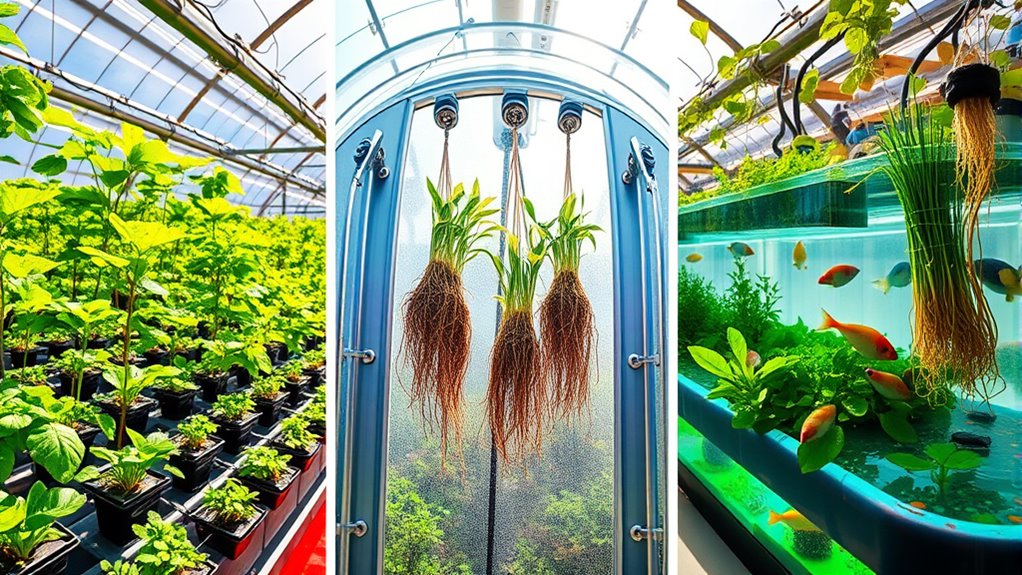
Different hydroponic, aeroponic, and aquaponic systems impact the environment in unique ways, influencing their sustainability and ecosystem benefits. Hydroponics uses less water, reducing pollution prevention concerns associated with runoff. Aeroponics minimizes resource use further, lowering energy consumption and waste. Aquaponics integrates fish, supporting biodiversity conservation by creating a balanced ecosystem. It also prevents pollution through natural filtration of fish waste. Visualize thriving green spaces with minimal water use, fish swimming peacefully among plants, and reduced chemical runoff protecting nearby ecosystems. These systems can decrease the environmental footprint of agriculture, promote biodiversity, and help conserve resources. Choosing the right system aligns with your environmental goals, whether it’s pollution prevention or ecosystem preservation.
Evaluating Ease of Operation and Technical Skills Needed

While each of these systems offers unique benefits, their ease of operation and the technical skills required can vary considerably. Hydroponics generally involves moderate automation complexity, requiring some technical expertise to set up nutrient delivery systems and monitor pH levels. Aeroponics tends to be more technically demanding, with intricate misting systems that need precise calibration and regular maintenance. Aquaponics combines fish care with plant growth, adding complexity as you must understand both aquaculture and hydroponic principles, demanding a higher level of technical expertise. Overall, hydroponics is often the most accessible for beginners, while aeroponics and aquaponics require more advanced skills and familiarity with automation technology. Additionally, understanding regional flavors and traditions can enhance your culinary experience if you’re integrating these systems into food production. Your choice depends on your comfort level with technical tasks and willingness to troubleshoot complex systems.
Considering Space and Scalability Options

When planning your system, you’ll want to consider how much space you have and how easily it can grow. Each method offers different benefits and challenges in scaling up, whether vertically or horizontally. Understanding these options helps you choose a setup that fits your space and future expansion goals. Additionally, evaluating the growth potential of each system can help you determine which setup will best support your long-term gardening ambitions.
Space Efficiency Potential
Hydroponics, aeroponics, and aquaponics each offer unique advantages in maximizing space efficiency and scalability. You can fit these systems into tight urban environments, making them ideal for urban integration. They allow vertical stacking, transforming limited areas into productive farms. With aesthetic design in mind, these setups can blend seamlessly into community spaces or rooftops. Picture:
- Vertical towers that optimize height without consuming extra ground space
- Multi-layered racks creating lush, green walls
- Compact, sleek containers fitting into small corners
- Floating platforms that utilize water surfaces creatively
These systems’ flexibility means you can scale up easily, adapting to different space constraints. Their design focus supports both efficient use of space and appealing aesthetics, perfect for urban growers aiming to maximize yields in minimal areas. Additionally, incorporating natural materials like wood and stone can enhance the rustic charm while maintaining functionality.
Scalability Challenges and Benefits
Scaling hydroponic, aeroponic, and aquaponic systems offers significant benefits but also presents notable challenges, especially regarding space and infrastructure. Scalability challenges include the need for larger, more complex setups that require careful planning and investment. As systems grow, maintaining ideal conditions becomes harder, risking reduced yields or system failures. However, scalability benefits are substantial: larger systems can produce more food efficiently and support commercial operations. They also allow for diverse crop varieties and year-round production. Your ability to expand depends on balancing these challenges and benefits, ensuring your space and resources align with your growth goals. Proper design and management can maximize scalability benefits while minimizing challenges, making your system more productive and sustainable at larger scales.
Vertical and Horizontal Options
To expand your hydroponic, aeroponic, or aquaponic systems effectively, you need to contemplate how to optimize space through vertical and horizontal arrangements. Vertical farming allows you to maximize limited space by stacking plant layers, ideal for urban settings. Horizontal cultivation spreads plants across ground level, making maintenance easier and providing better airflow. Combining both options offers flexibility for scalability and productivity. Visualize towering racks filled with leafy greens or sprawling beds stretching across your yard. Consider installing vertical systems for high-density growth and horizontal beds for larger plants or root vegetables. This strategic mix enhances space efficiency, supports scalable growth, and adapts to available resources. Whether you choose vertical farming or horizontal cultivation, your setup should align with your space constraints and future expansion goals.
Determining Suitable Crops and Plant Compatibility
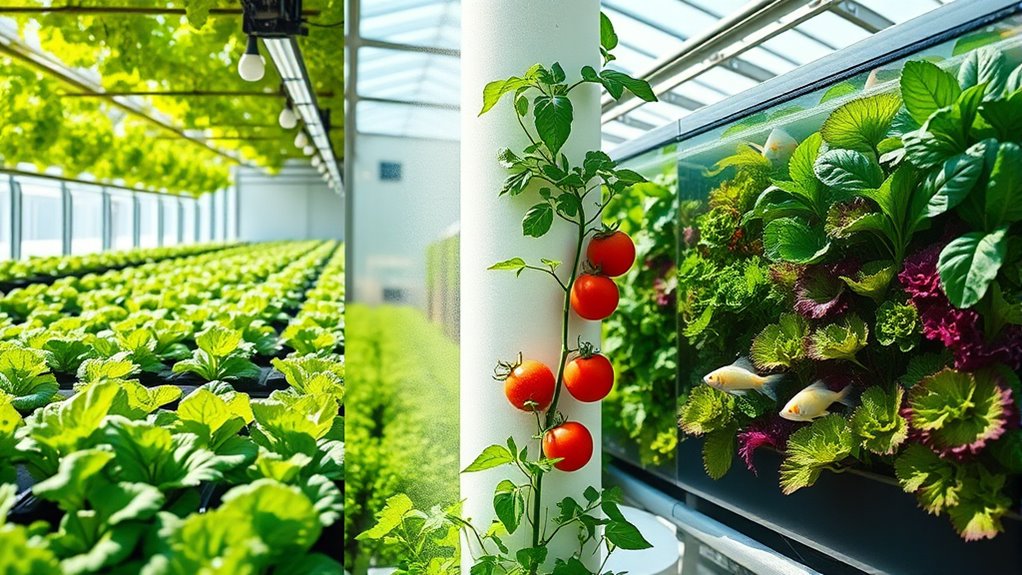
Choosing the right crops for hydroponics, aeroponics, or aquaponics depends on understanding each system’s strengths and limitations. Your plant selection should focus on crop adaptability, meaning how well plants thrive in the specific environment. Leafy greens like lettuce and herbs are ideal because they grow quickly and adapt easily. Fruit-bearing plants such as tomatoes and strawberries can also do well if the system provides proper support and nutrients. Consider the growth rate, root structure, and nutrient needs of each crop. Some plants require more space or specific conditions that may not suit all systems. Additionally, understanding plant adaptability helps in selecting crops that will flourish in the chosen system. By evaluating these factors, you can optimize your crop choices to maximize yield, health, and system efficiency.
Frequently Asked Questions
Which System Is Best for Small Urban Gardens?
For small urban gardens, you should consider aquaponics because it combines fish and plants, maximizing space. It promotes sustainable practices like composting methods for organic waste and water conservation through recirculation. This system is efficient and eco-friendly, making it ideal for limited spaces. Plus, it offers fresh produce and fish, turning your small garden into a productive, sustainable environment that benefits both your food needs and the planet.
How Do Pests and Diseases Differ Among These Systems?
Ever wondered how pests and diseases differ across growing systems? You’ll find that pest control and disease prevention depend heavily on your setup. Hydroponics typically faces fewer pests due to its sterile environment, while aquaponics can attract pests from fish tanks. Aeroponics minimizes disease risk with its closed, air-based roots. Regular monitoring and good hygiene are essential in all systems to keep pests at bay and prevent disease spread.
Can These Systems Be Integrated Into Existing Farms?
You can definitely integrate these systems into existing farms, but it depends on system compatibility and your farm’s infrastructure. Aquaponics integration often requires adjusting water management and plumbing, while hydroponics and aeroponics might need space modifications. Evaluate your farm’s current setup and goals to choose the best fit. With proper planning, combining these systems can boost productivity, sustainability, and resource efficiency effectively.
What Are the Long-Term Maintenance Challenges?
You’ll face ongoing maintenance challenges that impact system longevity and require regular attention. Frequent maintenance might include cleaning, checking nutrient levels, and repairing pumps or filters. Over time, neglect can lead to system failures or reduced efficiency. To keep your system running smoothly, you need to stay consistent with maintenance frequency, troubleshoot issues promptly, and invest in durable equipment to extend its longevity and guarantee healthy plant growth.
How Do Nutrient Management Practices Vary Across Systems?
You might think nutrient management is similar across systems, but it’s quite different. In hydroponics and aeroponics, you focus on precise nutrient balancing and frequent water recycling to prevent buildup or deficiencies. Aquaponics combines fish waste with plant needs, requiring you to monitor both water quality and nutrient levels carefully. Regular testing and adjusting are key, ensuring ideal growth while maintaining a healthy, sustainable environment.
Conclusion
Choosing between hydroponics, aeroponics, and aquaponics is like picking the perfect tool for your gardening toolbox. Each system offers unique benefits, so consider your space, budget, and sustainability goals. Think of it as planting a seed—you’ll nurture it best when you understand the roots. Whichever system you select, you’re set to grow thriving crops and cultivate a greener future, turning your gardening dreams into a flourishing reality.
